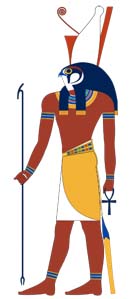Horus | The Egyptian Falcon God
Horus the falcon god was Egypt’s first national god worshiped by all of Egypt. One of the most important gods of ancient Egypt, the worship of Horus spanned over 5,000 years. With mention in records from the late pre-dynastic period through Roman times, Horus became the catch-all name for many different gods associated with falcons. Egyptian mythology features many different versions of his name, family and importance.
Many Names, Many Gods
Featured as a royal man with the head of a falcon or hawk, Horus often holds a scepter and ankh. His white and red crown represented the unity between Upper Egypt and Lower Egypt. Horus is also seen as having the body of a lion, the head of a hawk and even as the sphinx.
The name Horus means “the one far above,” which indicated his importance above all other gods of Egypt.
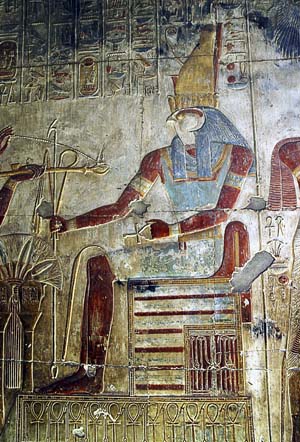
© Rhys Davenport - Horus - Temple of Seti I
Horus was also known as:
- Sun God
- War God
- Hunter's God
- God of Kingship
- God of the Dawn
- Keeper of Secret Wisdom
- Son of Truth
- Horus the Avenger
- Horus Lord of the Two Lands
Because of the many different names and forms of Horus, Egyptologists find it impossible to identify the one true falcon god. Despite the many different variations, Horus is always seen as the ruler of the gods represented by a falcon. He was also known as the patron saint of the existing pharaoh, who was often referred to as the 'Living Horus'.
The Son of Ra
In the earliest forms Horus is known as Horus the Elder. First seen in pre-dynastic Upper Egypt, neighboring tribes most likely brought stories of Horus into Egypt. Egyptians quickly adopted him into Egyptian mythology as the son of Ra and one of the creator gods. Horus took the form of a falcon and flew up at the beginning of time as part of the creation. Also known as Horus of Two Eyes, his left eye represented the sun and his right eye represented the moon. With the power of the sun and the healing of the moon, Horus ruled both the day and the night. In the earliest forms, Egyptians viewed him as the brother of Osiris and Seth.
Over time, Egyptians began to combine the idea of Horus and Ra into one god, Ra-Harakhte. Often pictured with a solar disk behind his head, the Ra-Harakhte version of Horus was the sun god, responsible for the sun’s path across the sky.
The Son of Osiris
In approximately 2350 BCE, Egyptians began to view Horus as the son of Osiris and Isis. One of the most popular Egyptian myths focuses on the birth of this form of Horus. Known as Harsiesis, or Horus the Younger, this version of Horus was born the son of Osiris and Isis.
Egyptians viewed Osiris as a god of peace and prosperity. His younger brother, Seth, became jealous and destroyed Osiris by trapping him, drowning him and distributing the pieces of his body all over the world.
Osiris’s wife and sister, Isis, gathered all the pieces of Osiris together. With the help of Anubis, the two performed the first Egyptian embalming to prepare Osiris for the afterlife. With magic, they were able to bring Osiris back to life for a short period of time. Isis became pregnant during this time, later giving birth to Horus. Isis and Hathor protected the young Horus until he was old enough to rule. As a child, he is often seen located next to Isis on a lotus leaf.
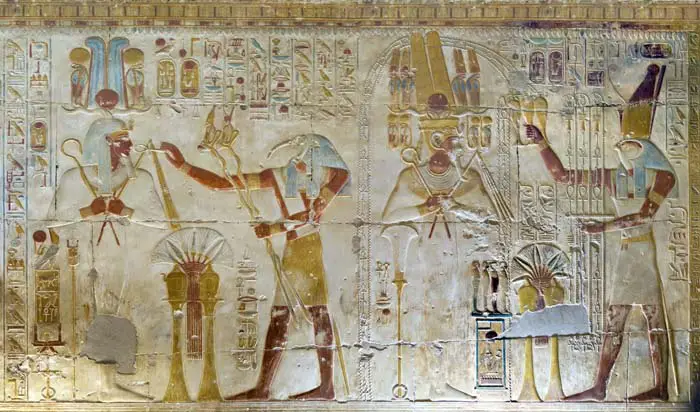
© kairoinfo4u - Temple of Seti I at Abydos
Triumph over Seth
During the first dynasty (c. 2925-2775 BCE) Egyptians viewed Horus and Seth as bitter enemies in a fight to rule the world. With Horus situated as a favorite among the gods, Seth’s hatred grew. Egyptian mythology tells many stories recounting battles between Horus and Seth. The battle between Horus and Seth reached Egyptians as a story of hope. In a time of frequent rebellions and invading occupiers, the defeat of Seth became a powerful symbol. Many Egyptian temple reliefs show Horus’s triumph over Seth in a variety of tales.
One story as an example of this features Horus and Seth turning into hippopotamuses to battle in the waters of the Nile. For many years, Pharaohs would arm themselves with a spear to kill a hippopotamus in a reenactment of the battle. This served as a message to their people that they were all powerful over those threatening their rule.
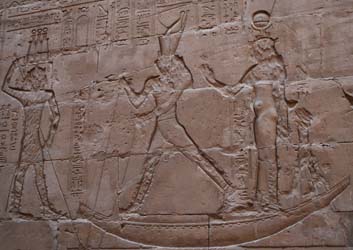
© Adrian Hayter - Horus & Pharaoh killing Seth
The Eye of Horus
Horus the Egyptian falcon god is often associated with the "Eye of Horus'; a symbol that is prominent throughout Egypt even until modern times. This symbol was found on the mummy of King Tut.
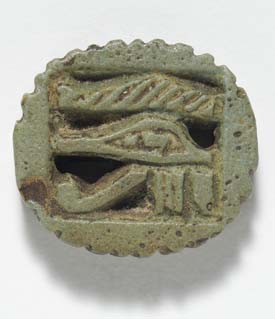
© Ashley Van Haeften - Eye of Horus Amulet
In one epic Egyptian myth, Seth damaged Horus’s left eye. The damage to what was known as the “moon eye” set in motion the phases of the moon. The god Thoth was able to restore Horus’s damaged eye. The eye of Horus, represented as the wedjat eye, was born as one of the most powerful and popular symbols of Egypt. It was seen as the watchful eye. The eye saw everything and protected the world from the always threatening chaos.
Often seen as funerary amulet, the eye became a symbol of protection for a king in the afterlife.
It was also believed to ward off evil. Ancient Egyptian sailors painted the eye on the bow of boats for safe travel. The most famous usage of the eye was on the mummy of the young King Tutankhamen.
Click here to learn more about The Eye of Horus
Protector of the Pharaohs
Egyptians viewed Horus as the protector of the Pharaoh. As a god known in all of Egypt, he was an important unifying tool used to tie the people together under their leader. Great efforts were taken by rulers to show themselves as Horus in human form. When associated with a pharaoh, Horus was represented as a hawk resting on the shoulder of the pharaoh with his wings spread around the pharaoh’s head. Pharaohs would take on a Horus name to tie themselves to the god in both their reign and their afterlife.
In believing that Horus ruled the Earth under the authority of the gods, it was important for Pharaoh to become Horus in a living form. When the Pharaoh died, this association would unite the ruler with Osiris in the underworld. Horus would then move into the form of the next pharaoh.
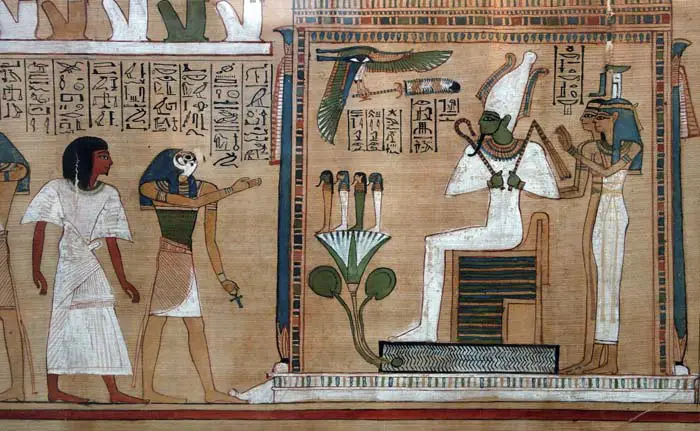
© Steven Zucker - Hunefer's Book of the Dead detail, with Horus and Osiris
Temples and Cults
As early as the late pre-dynastic times, cults began associating with Horus. Although cults were common for Egyptian gods, many cults focused on specific local gods. Horus was a well-known god with popularity throughout all of Egypt. Examples of his importance are found throughout all of Egypt in temple remains, monuments and coffin texts.
The most significant tribute to Horus stands as the Temple of Edfu. Located 60 kilometers north of Aswan, the structure is considered one of the best preserved temples in Egypt. Cult worship of Horus began in the Delta, spreading south throughout the reign of Ptolemy III. Construction of the temple began around 237 BCE. Over the course of the 180 years of construction, Horus was worshiped at Edfu for constantly battling Seth and protecting the world from darkness.
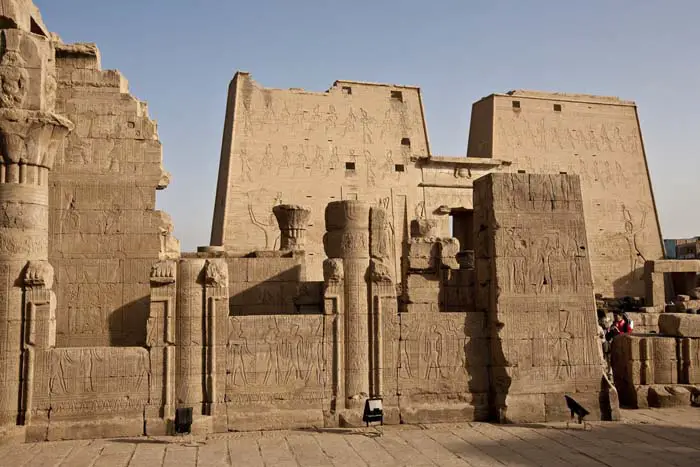
© alh1 - Egypt, Edfu temple
Horus and Jesus
During the Hellenic period, Horus began to be identified as the reincarnation of Osiris. He was seen as both his father and the son of his father. This mythology combined with the philosophy of Plato, becoming popular in the Mediterranean as a mystery religion basis for many different gods. The magical conception of Horus as the son of Osiris gives roots to the ideology that the basis for the story of Jesus has its roots in the mythology related to Horus.
Critics of the history of Jesus say that the parallels between the ideology of Horus and that of the story of Jesus indicates that they are the same story, just different time periods. However, this idea fails to take into account that the belief in Horus is one that spans thousands of years and many different versions. Each era of belief in Horus would have believed in different versions of the god, none of which match up with the accounts of Jesus.

